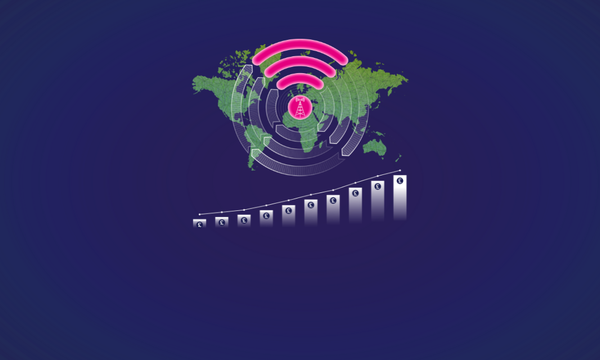
The road to 5G: we’re talking about my generation
This article is from the CW Journal archive.
With all the world talking about 5G one could be forgiven for thinking that it’s a vitally important standard, and already providing a useful service. The press is awash with articles about 5G chips being built, 5G networks deployed, and 5G applications developed: well, that’s quite an achievement for a standard which hasn’t been written yet, and won’t even be completed for another few years at least.
We’re told 5G devices should connect to a network in a hundredth of a second, download data at 20 Gigabits per second, with a latency of less than a millisecond, and all for less cost (both capital expenditure, or capex, and operating expenditure, or opex) than today’s networks.
Quite how the standard plans to achieve this will be our subject here, and we’ll also discuss why the numbers above are so important.
Generational changes are becoming hard to quantify (see sidebar) but the 3GPP – the international body generally recognised as being responsible for establishing what “5G” should do – has been quite specific:
- Mobile broadband peak data rate should be 20Gbps for downlink and 10Gbps for uplink
- Low-latency communications should offer a latency of less than half of a millisecond
- The design of the RAN architecture should enable lower capex/opex, with respect to current networks, and achieve the same level of services
- The 3GPP has decided to accelerate development of enhanced Mobile broadband, or embb, and in March this year announced that it had agreed to have “an intermediate milestone for the early completion of the non-standalone (NSA) 5G New Radio (NR) mode for an embb use-case”
|
GET CW JOURNAL ARTICLES STRAIGHT TO YOUR INBOX Subscribe now |
5G is also being touted as the technological solution for connecting billions of “things”, from gas valves to baby carriages. These items are expected to form part of a huge industrial market, but various industries will need to tread very carefully to avoid undermining their existing efforts, creating confusion, and developing multiple standards.
Wide area networks are already being deployed to connect all these things, but it’s not just the traditional CSPs that are building them.
Networks operating in unlicensed radio bands – such as Sigfox, LoRa, RPMA and Weightless – are enabling a new generation of mobile operator which doesn’t need billion-dollar investments in radio spectrum or infrastructure. In fact, these upstart competitors are already claiming national coverage in some regions.
In response, the 3GPP has developed LTE-Cat M1 and Cat-NB1. The former is a half-way house carrying voice as well as data, while the latter (also known as NB-IoT) is seen as a direct competitor to the upstart operations.
NB-IoT networks are being rolled out (albeit slowly) despite the fact that this is often a case of software upgrades rather than new hardware.
Gas valve and baby carriage use means a lifespan measured in decades. So, if the mobile industry is to avoid being usurped by Sigfox, LoRa, et al, then the commitment to NB-IoT has to be wholehearted and for the long haul.
That means that NB-IoT will need to be (and some would say it already is) part of the 5G standard, or at least compatible with it.
So, expect to see NB-IoT neatly folded into the 5G standard with the minimum of fuss.
The headline-grabbing speed of 5G is only practical using very high frequencies. Today’s mobile networks are squeezed between existing radio users – and contiguous blocks of radio spectrum are rare – but the high frequencies (24ghz, 28ghz, even 39ghz) aren’t full of omnidirectional emitters, though they are used for highly directional point-to-point links.
This means that 5G technology placed there can stretch out and relax. A current 3G radio signal occupies 5mhz of radio spectrum, but Qualcomm’s latest (pre-standard) 5G chip can fill 800mhz, and up above 6ghz there’s more than enough room to do so.
Bands above 6ghz haven’t been used for mobile in the past because they’re hard to work with, offering very short range and limited penetration. A 28ghz signal will struggle to penetrate a building, unless there’s a lucky line of sight through a window, but with enough base stations it’s possible to provide coverage.
Those base stations will need to be close together, so think lamp posts, not hilltop transmitters – and consider the problems of wrapping directional antennas round the outside of lamp posts. Fortunately, high frequencies does mean small antennas so this might not be insurmountable.
Away from city streets longer range will be needed, so 5G will have to squeeze into available slots at 3.5ghz, or the newly-vacated TV channels around 600mhz.
These broadcast TV frequencies aren’t as empty as the high-frequency bands, but they can slice through buildings over distance. There will also be the option of using legacy LTE bands. So, to provide universal service 5G networks will use a combination of radio bands, and offer those headline speeds only at the higher frequencies.
It may seem as though mobile telephony has progressed smoothly through the generations, climbing a clear staircase of technologies and following usefully-numbered innovations. Sadly, this is far from the truth. The days when radio engineers put names on things are long gone, if they ever existed. Today, it’s the marketeers who decide in which generation a specific technology might fall, and we’re only going to go further down that path.
1st Generation
The first generation of cellular networks used an analogue radio transmission, were unencrypted, and had laughable security and poor authentication. But they were also, without doubt, a technological and social revolution.
It is the analogue encoding which defines these as First Generation, and (coincidently) meant you could tune into a phone call using nothing more complex than a radio receiver (a fact that surely must have come as a big surprise to Prince Charles and Lady Di).
2nd Generation
By the middle of the 1980s it was clear that better standards were needed. These are collectively known as “2nd Generation” as they use digital encoding, have some form of cryptographic protection, as well as incorporating a reasonably-secure authentication system.
In Europe, GSM was defined and regularly enhanced during its life. GPRS, or General Packet Radio Service, provided data, and was itself enhanced with EDGE (Enhanced Data rates for GSM Evolution) for faster data services.
3rd Generation
The networks fully expected that 3G would be used for video calling, which in fact turned out to be obscenely expensive and not very useful. Fortunately, the net had come along and made data sexy, so users quickly filled the 384kb/s, wanted more speed, and things started to get complicated.
High Speed Packet Access (HSPA) can be appended to 3G to ramp up the speed. For some marketeers (notably those at T-Mobile USA) that was enough to claim a “4G” moniker, while others tried out a “3-point-something” label.
When surveyed it seems that the public thinks “3G+” is faster than “3.5G”, and “3.75G” is faster still, but none of these terms term have any meaning outside a telco’s marketing department.
4th Generation
This is generally recognised to be LTE (Long Term Evolution), but at launch LTE just wasn’t fast enough. The top speed of LTE was only 300Mbps, and by this time the 3GPP had agreed with the ITU that this was not 4G. Clearly the operators deploying LTE (and WiMAX) would have to advertise it as “3.9G”, or something like that. Wouldn’t they?
Undaunted, many marketeers just went ahead and announced they had 4G networks and/or handsets. Eventually the ITU (and, by extension, the 3GPP) admitted defeat and agreed that both LTE and WiMAX could be called “4G” even if they weren’t really.
The moniker “True 4G” is sometimes used nowadays for networks or equipment matching the original criteria, but it’s not widely employed as it does rather imply that any previous 4G claim might have been untrue.
Also it doesn’t fit well next to signal-strength bars on a smartphone screen.
5th Generation
Which brings us up to date – with marketeers cherry picking technical standards while radio engineers look on with horror at the mishmash of technologies that will soon be sporting a “5G” sticker. What a world!
Speed is one thing, but increasingly important is latency. This is the time it takes for a request to be answered, such as asking for a web page, and that web page starting to arrive back on your device.
Ofcom, the UK’s broadcasting and telecoms regulator, measured latency on the UK mobile networks in 2015, finding that networks based on 3G standards would respond in 63.5ms, while 4G networks could get a response back in 53.1ms.
That might seem impressive – 100ms is considered fine for online – but if you are directing a self-driving car you need a faster network.
The 5G standards call for latency of less than 1ms, which is certainly faster, but is going to be much harder to achieve. As a comparison, 4G has a theoretical latency of 10ms or so, meaning that the vast majority of the latency that Ofcom found wasn’t caused by the radio communications but by the controlling network, and the connection to the server being queried.
Reducing the radio component to a latency of less than 1ms won’t have a massive impact on the overall latency, unless other technologies and techniques are harnessed and adapted to reduce the travel time.
mobile developers have always excelled at filling the available bandwidth, but 5g's huge capacity could challenge even them
To reduce latency to these levels, the number of stages of packet routing has to be drastically reduced. A good deal of the cloud processing has to be moved right to the edge of the network, “loif the brain controlling a drone is located in the nearest base station then low latency is much easier to achieve, simply because the data isn’t travelling so far. We can’t put drone brains into every base station, so 5G base stations will have to have flexible hardware capable of taking on whatever edge processing is needed.
The decision-making logic of our putative drone will have to travel with it, jumping from base station to base station so it’s never far from the drone itself.
Meanwhile let’s not forget that 5G networks are supposed to be cheaper to build, and run, than existing networks. Network intelligence can go a long way to reducing costs – self-configuring small cells should be cheaper to fit, and self-organising networks can reduce management costs.
However, those advantages must be weighed against the number of cells needed, and the cost of radio spectrum for them to use.
The ultimate question facing 5G is not what, or how, but why. What applications need (and will pay for) network speeds measured in tens of gigabits a second? A single 5G connection, at 20Gbs, will be able to carry 800 simultaneous video streams in Ultra HD. Mobile developers have, over the years, excelled at filling the available bandwidth, but this could challenge even them.
Ultra-low latency sounds really cool, but to make it work we also need edgecloud microservers to minimise routing delay.
We are entering a new world, where the limitation on our connectivity now isn’t the last mile. As an industry we have, quite rightly, been obsessed with the limitations of last-mile connectivity. With 5G, those limits disappear into the distance, revealing new choke points and new challenges for a new generation of wireless apps.
In this context the UK Government’s published 5G strategy1, which will create a “new national 5G Innovation Network to trial and demonstrate 5G applications” is very welcome.
Simon Rockman bridges writing about technology and implementing it. As the editor of UK5G Innovation Briefing he visits many of the 5G applications. As Chief of Staff at Telet Research he works with a team installing 5G networks in not-spots. An experienced technology writer, he was the editor of Personal Computer World in the late 1980s and went on to found What Mobile magazine which he ran for ten years, and has reviewed over 300 handsets. As the mobile correspondent for The Register, he championed CW writing a number of articles supporting the organisation. He has also had senior roles in telecoms having been the Creative Experience Director at Motorola where he looked at new uses for mobile and Head of Requirements at Sony Ericsson where we worked on innovative devices at entry level. He was the Head of the Mobile Money Information Exchange at the GSMA and has launched Fuss Free Phones an MVNO aimed at older users











